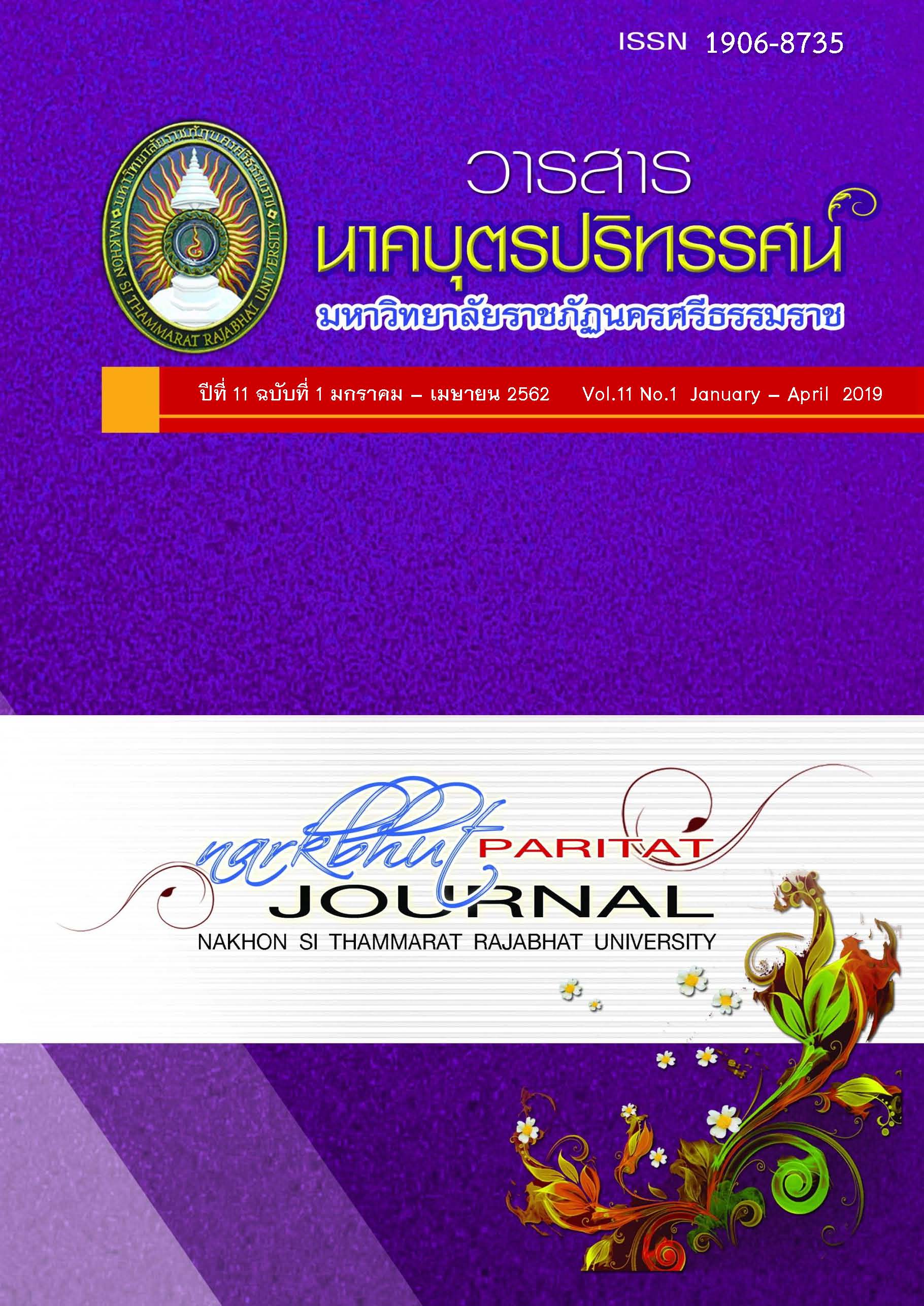รูปแบบการจัดการสุขภาพที่เหมาะสมของนักศึกษาในมหาวิทยาลัยราชภัฏนครศรีธรรมราชAppropriate Health Management Model for Students of Nakhon Si Thammarat Rajabhat University
Main Article Content
Abstract
บทคัดย่อ
การวิจัยครั้งนี้มีวัตถุประสงค์เพื่อศึกษาสภาพการจัดการสุขภาพของนักศึกษา และสร้างรูปแบบ การจัดการสุขภาพที่เหมาะสมของนักศึกษาในมหาวิทยาลัยราชภัฏนครศรีธรรมราช เป็นการวิจัยแบบผสมผสาน เก็บรวบรวมข้อมูลจากนักศึกษา จำนวน 421 คน โดยการสุ่มกลุ่มตัวอย่างตามวิธีของยามาเน่ และกลุ่มผู้ให้ข้อมูลหลัก จำนวน 15 คน โดยการเลือกแบบเจาะจง เครื่องมือที่ใช้ในการเก็บรวบรวมข้อมูล ได้แก่ แบบสอบถาม แบบสัมภาษณ์ และการสังเกตแบบไม่มีส่วนร่วม วิเคราะห์ข้อมูลด้วยค่าความถี่ ค่าร้อยละ ค่าเฉลี่ย ค่าส่วนเบี่ยงเบนมาตรฐาน และการวิเคราะห์เนื้อหา
ผลการวิจัยพบว่า 1) สภาพการจัดการสุขภาพของนักศึกษาในภาพรวมอยู่ในระดับปานกลาง โดยด้าน
การจัดการอยู่ในระดับมากที่สุด รองลงมาคือ ด้านวัสดุอุปกรณ์ และด้านบุคคลอยู่ในระดับต่ำสุด 2) รูปแบบการจัดการสุขภาพที่เหมาะสมของนักศึกษาในมหาวิทยาลัยราชภัฏนครศรีธรรมราช ใช้ชื่อว่า “NSTRU Model” มี 5 องค์ประกอบ ได้แก่ (1) สร้างเครือข่ายในการทำงาน (Networking) หมายถึง การสร้างเครือข่ายความร่วมมือกับหน่วยงานที่เกี่ยวข้อง (2) ค่านิยมร่วมกัน (Shared Values) หมายถึง การมีอุดมการณ์ค่านิยมร่วมในการทำงานเพื่อพัฒนาการจัดการสุขภาพไปสู่เป้าหมาย ( 3) การรักษาพยาบาลเบื้องตน (Treatment) หมายถึง การคัดกรองอาการเจ็บป่วยและปฐมพยาบาลเบื้องต้น (4) การกระจายทรัพยากร (Resource Mobilization) หมายถึง การกระจายทรัพยากรต่าง ๆ ให้ครอบคลุมทุกภาคส่วน และเปิดโอกาสให้บุคลากรที่เกี่ยวข้องได้เข้ามามีส่วนร่วมในการจัดการสุขภาพ รวมทั้งมีการกำกับ ติดตามประเมินผลการดำเนินงานอย่างต่อเนื่อง (5) การใช้เทคโนโลยี (Using of Technology) หมายถึง การจัดทำระบบฐานข้อมูลกลาง และการนำระบบเทคโนโลยีสารสนเทศเข้ามาใช้เป็นช่องทางในการติดต่อสื่อสารในด้านการจัดการสุขภาพแก่นักศึกษา
Abstract
The purposes of this research were to study the state of health management of students in Nakhon Si Thammarat Rajabhat University (NSTRU) and to set the appropriate health management model for the students of NSTRU. The research was mixed research. Data was collected from 421 students by using random sampling method of Yamane. Purposive selection method was used to choose 15 key informants. Data collection tools were questionnaire, interview, and non-participant observation. Data was analyzed by using frequency, percentage, average, standard deviation, and content analysis.
The research shows that 1) an overview of the state of student health management was at average level. Considering each aspect, the management aspect was at the highest level. Next below was tool and material aspect. Personnel aspect was at the lowest level. 2) the appropriate health management for the students of NSTRU was named “NSTRU Model”. NSTRU model consists of 5 elements which are (1) Networking: network and cooperation building among related organizations (2) Shared Values: working with ideology and shared values to develop health management toward achievement of development goals (3) Treatment: triage and primary medical care (4) Resource Mobilization: spreading resource mobilization for all sectors, giving an opportunity to people to have a part in health management, and following up continuously the operation (5) Using of Technology: making central data based system and bringing information technology to used as communication channel for the student health management.
Article Details
References
Autthayotha, N. (2012). Health Management in Local Fund Health Security by Public
Network at Maesuk Sub- district. Maechai District, Phayao Province. Master of Nursing Science (Community Nurse Practitioner). Chiangmai University.
Chamchai, S. (2010). Development of an Appropriate health Management Model for
Informal Workers in Doi Saket District, Chiangmai. Doctor of Philosophy (Rural Planning
and Development). Maejo University.
Chareonpan, J. (2009). Development of Community Health Promotion Model for
Sustainability by Community Network for Public Health System Development.
Master of Public Health (Public Health). Naresuan University.
Cronbach, L. J. (1970). Essentials of psychological testing (3rded.). New York: Harper and Row.
Kamukda, Y. (2011). An Appropriate Model of the Public Health Management by Local
Administrative Organization in the Upper Part of Central Thailand. Doctor of
Philosophy (Cultural Science). Mahasarakam University.
Phota, W. (2005). Health Management by District Network, Nonthaburi: Health Training
and Development Center for Central Region People. Ministry of Public Health.
Rujiwannakul, S. (2015). The Development Model for District Health System through
Knowledge Management and Learning Process within Local Networks: A case study of Khunhan District, Srisaket Province. Master of Public Health (Public Health). Mahasarakham University.
Techakosol, P. (2004, July–September). Community Health Management in Changwat
Khonkaen. Journal of Humanities and Social Sciences, 21(2). Khonkaen University.
Yamane, T. (1973). Statistics-An introductory analysis (3rded.). New York: Harper and row
publication.


